Forums:
The first Epi's are in flower here :D :D :D
E. x versicolor 'Cherry Tart'
E. x warleyense (I suspect this is E. x warleyense 'Orangekönigin', like the one on the next pic...but I'm not sure, so until I'm sure I'll keep it named as the pure hybrid)
E. x warleyense 'Orangekönigin'
and a very young plant of E. x youngianum 'Freckles' Cc. 950080 (2 last pics)




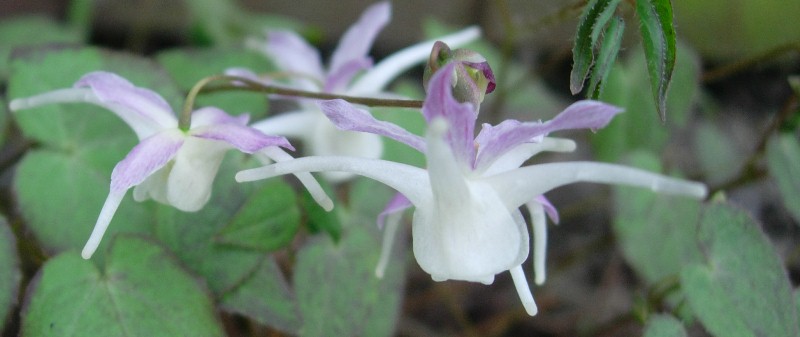
Comments
Mark McDonough
Re: Epimedium 2011
Tue, 05/03/2011 - 9:42amWim, your season is closing so soon? Of course, your season started much sooner than here. I'm going to the open-nursery weekend at Garden Vision Epimediums (now at a new location, run by Karen), and I hope to pick up E. dolichostemon, yet another one on my wish list, I like the shape of the flowers. Last year I finally moved my E. grandiflorum 'Yellow Princess', it has never performed well, probably too dry where I had it, and with the flowers I'm always hoping to see a brighter display, although it is a nice smaller-sized grandiflorum with flowers the color of forma flavescens forms.
I was looking around on the web and found this gallery of Epimediums, some of which I'm unfamiliar with:
http://www.visionspictures.com/index.php?module=result&searchKey=Barrenwort
Anyone familiar with the following cultivars: Star Cloud (looks like an E. stellulatum cultivar), Madame Butterfly, Flowers of Sulphur (I know this one is going around in the UK and Europe, haven't seen it here in the USA yet), Egret (the one I like the most, beautiful white and yellow combination, elegant flower shape), and Big White (looks like a pale acuminatum type hybrid).
Direct links to two 'Egret' photos:
http://img.visionspictures.sodatech.com/ELBO/wprev/elbo54993.jpg
http://img.visionspictures.sodatech.com/ELBO/wprev/elbo54994.jpg
WimB (not verified)
Re: Epimedium 2011
Tue, 05/03/2011 - 10:34amWe have had a very warm and dry spring here in Belgium...so the flowers started early but most of them are going over now :'( Still have the beautiful leaves for the rest of the year, though :D
I've never heard of Star Cloud.
Madam Butterfly is a selection made by Robin White which gives a lot of flowers above the evergreen leaves...don't grow it myself but it has been for sale here in Belgium for a couple of years.
Flowers of Sulphur is a E.flavum x E. ogisui hybrid made by Robin White
Egret is one of the best spreaders, evergreen, carries it's large long-lasting flowers above the evergreen leaves, it's a E franchetii x E. latisepalum hybrid. If I remember correctly it's a hybrid made by Thierry Delabroye (His nursery is not far away from where I live, just across the border in France and he is very famous for his Helleborus crosses: http://www.mytho-fleurs.com/images/Delabroye/Hellebous-13-02-2005/page_0...).
Don't know Big White either.
gerrit (not verified)
Re: Epimedium 2011
Tue, 05/03/2011 - 12:51pmThis weekend at Garden Vision Nursery their open weekend indeed. I received their catalogue and I wish I was there. So many desirable epimediums but also beautiful primulas. E.gr.'Pierres Purple, E.gr.Princess Susan' E.gr. Saxton's Purple' and so on.
Mark please show us pictures as many you can here.
Mark McDonough
Re: Epimedium 2011
Tue, 05/03/2011 - 6:52pmGerrit, I tried to come home promptly tonight after work, with just a bit of light left, to take some photos, but only some came out okay, the low light is not the best for photography. Epimedium grandiflorum 'Princess Susan' is one of the best, a clear pink and white that sets the standard buy which other clear bicolor epimedium flowers are judged. Yet another spontaneous hybrid in the garden of Harold Epstein, this one named for his daughter. So far as purple grandiflorums go, 'Purple Prince' is by far the best and darkest purple. The shots I took tonight do not do it justice. 'Pierre's Purple' and 'Saxton's Purple' are both nice, but frankly not as good as 'Purple Prince'. I'll try and get shots on the weekend when I have sunlight.
Mark McDonough
Re: Epimedium 2011
Tue, 05/03/2011 - 7:08pmAgain, photographed in the warning light of dusk, these photos of Epimedium hybrids (2-4 year plants) should give some account of the anticipation of seeing hybrids bloom, to assess their potential... such fun, wish I could see them by daylight.
1-3: a bright cherry pink color with a white star on top of the sepals. In the first view, some other hybrids blooming for the first time.
4: my super-floriferous dwarf seedling from youngianum 'Liliputian'.
5: a colorful 1st bloom on a seedling with bright spring foliage and largish lavender and white flowers.
6: a dwarf hybrid seedling from 'Liluputian', with light pink and white flowers, odd recurved sepals, often just two sepals instead of four.
7-8: A sempervirens hybrid (possibly crossed with grandiflorum f. flavescens) with yellow and white flowers and light bronze foliage (foliage turns deep near-black in late fall). Still in early flower.
9: a small cherry color one, 2nd year seedling.
10: E. grandiflorum f. flavescens hybrid with very dense and rather huge cream flowers, lightly bronzed foliage. Compact.
Richard T. Rodich
Re: Epimedium 2011
Tue, 05/03/2011 - 7:30pmWim's shot of E. dolichostemon is quite interesting as it shows the flower spurs as pinkish little curlicues. A characteristic that might be interesting for breeding(?).
A few first flowers of Orangekönigin opened today in my garden, the first warm day we've had in weeks. (Yesterday was 30 degrees F below normal.)
Mark McDonough
Re: Epimedium 2011
Tue, 05/03/2011 - 7:54pmI agree Rick, the flower shape on E. dolichostemon is truly unique. The hybrid that Gerrit and Wim have shown before, E. x 'Amanogawa' has as one of its parents E. dolichostemon. The form of E. dolichostemon that Garden Vision Epimediums sells has darker brownish-red spurs instead of pinkish ones, I suppose the plant is variable.
Included here are two shots of E. x warleyense 'Orangekönigin' that I happened to photograph tonight, for the purpose of noting the difference between it and regular warleyense. I don't have side by side shots, but I noticed that 'Orangekönigin' has dark orange spur tips, whereas they are greenish-yellow in regular warleyense. Flower color is a tad lighter orange with 'Orangekönigin' but I don't think I could tell the two apart on flower color alone, need to look at the spurs. Also, 'Orangekönigin' has yellow pollen whereas regular warleyense has green pollen.
gerrit (not verified)
Re: Epimedium 2011
Wed, 05/04/2011 - 1:03amIt's wonderful, to go out in the garden in the early morning, as I do with my wife, who has become enthusiast of epimediums too, or as you do after a day of working with your photocamera and admire the new flowers blooming, or the appearency of new hybrids flowering for the first time.
That super-flowering x youngianum 'Liliputian' is really unbelievable. Compliments from my wife too.
I'm happy, I could purchase E.gr.'Purple Prince', you mentioned above.
One of the last flowering epimediums here in my garden, Epimedium wushanense nova. I'm real proud of it. An impressive appearance, altough it is a young plant, flowering for the first time.
Todd Boland
Re: Epimedium 2011
Thu, 05/05/2011 - 3:33pmImpressive Epimedium displays! Those at our BG are now even showing themselves yet. I am just getting into these...recently purchased E. grandiflorum 'Saxton's Purple', E. wushanense and E. pubigenum 'Orangekinigin'.
Peter George
Re: Epimedium 2011
Thu, 05/05/2011 - 6:47pmTomorrow starts the 3 day Epimedium extravaganza here in Central Massachusetts, as Garden Visions has its annual sale. Over the past few years I've brought home about a dozen Epimedium species and hybrids, but the one that I look for first when I go out to the garden is E. x versicolor 'Versicolor.' The leaves and the flowers look almost too perfectly matched, and it's grown to a very impressive size in 3 years. It's easily my favorite, and tomorrow I'll bring home at least one more of this beauty, plus a few more I've lusted after for years.
gerrit (not verified)
Re: Epimedium 2011
Fri, 05/06/2011 - 6:55amLucky guy, living in the epicentre of the epimediumworld Peter. I like E. x versicolor 'Versicolor' too.
When you come back with you precious little E. show them please.
Mark McDonough
Re: Epimedium 2011
Fri, 05/06/2011 - 8:05pmGerrit, very nice... an impressive E. wushanense... a plant with such substance. Mine is just starting to open it's first flowers; I'm so pleased it is the weekend because I get to observe these beauties in more detail, maybe dab some pollen here and there. In the morning (Saturday), I shall be heading out to Garden Vision Nursery (indeed the epicenter for epimedium) with a friend, to pick up a small order.
Thanks for the compliments on the super-floriferous hybrid selection from E. x youngianum 'Liliuptian', but as a reminder, all of the hybrids that I currently show are the work of bees. But the ultra-floriferous one is a reminder to watch plants, give them space to develop, and watch them for 3-4 years to see what they are actually about in terms of growth characteristics, to reveal their special features. Next year I should be able to show a few seedlings plants in first-flowering from my manual crosses, and in 2 years, lots more.
Mark McDonough
Re: Epimedium 2011
Fri, 05/06/2011 - 8:10pmPeter, you characterized it well, this cultivar is amazing, with unique flower color and abundance of flowers, and perfectly matched vibrant foliage color within the same harmonious color range, that it is hard to beat. Feel free to ask for divisions of any Epimedium, I have about 200 types, and the number keeps growing :D
Mark McDonough
Re: Epimedium 2011
Sun, 05/08/2011 - 5:03amHeaded out to Garden Vision Epimediums on their "open nursery weekend" to pick up a small order. This year, the open house took place at Karen Perkin's residence in Phillipston Massachusetts (central MA). The morning was warm and sunny, with a haze of tree pollen burning my eyes and making me sneeze frequently and my nose run like the wind, and with swarming clouds of biting gnats, my fingers bloodied from whacking them off my forehead or when they enter my ear canals... ah, spring in rural Massachusetts. I reduced the gnat population slightly by inadvertently swallowing a few. ;D
Karen's property is rustic and scenic, with lots of grade change and beautiful stone outcrops and massive boulders. Already in a short time, the grounds are shaping up and looking great, showing much potential. And there they were, the rows of tables with Epimediums lined up alphabetically, such enticement. A couple "eppies" I wanted were not available, but still was able to add a modest number of new types to my collection, here's what I bought:
E. sempervirens 'Candy Hearts', E. elachyphyllum, E. flavum, 'After Midnight', 'Starlet', 'Flame Thrower', and Iris gracilipes Buko, I. cristata 'Navy Blue Gem', and I. cristata 'Brumback Blue'.
Flowering in her new display beds was an Epimedium from Diana Reeck at Collector's Nursery, named E. 'Hot Lips', visually jumping out from the rest with a low shield of waxy shiny bronzed foliage and uniquely hued flowers of light pink sepals, raspberry pink centers and long arched spurs that shade to near white at the tips. Wow! I want that one! Also looking fine, were clumps of Trillium pusillum 'Roadrunner' in perfect bloom.
Mark McDonough
Re: Epimedium 2011
Sun, 05/08/2011 - 5:17amHere's another hybrid selection, a 3-year old plant. It looks promising, with exceptional star-like flowers with long straight points, the sepals edged in purplish-pink creating a broad white star zone on the back of the sepals. The foliage is small and bronze-tinged. I'll try to get a photo when more fully developed and under better light conditions.
A veiw of a bed under Cornus kousa 'Milky Way' with about approximately 120 Epimedium hybrid seedlings, mostly 1-2 year olds and a few 3-year plants. This is the best part... getting to review new flowering on hybrid plants.
WimB (not verified)
Re: Epimedium 2011
Sun, 05/08/2011 - 5:23amWhat's a gnat? Something like a mosquito? I don't think we have those over here ;) We do have pollen though....always fun for someone with tree-pollen and grass-pollen allergies like me :(
Looks like you bought a nice selection...I wish we had such a selection of I. cristata cultivars to buy over here.
Those hot lips ;) look really nice....don't want it, need it!!!
Trillium pusillum is not very easy here, managed to kill it a couple of times already.
WimB (not verified)
Re: Epimedium 2011
Sun, 05/08/2011 - 5:27amVery nice, Mark,
the spurs look like they are elongating the star on the upper sepals. Name-worthy! Mark's Star ;D ;D
Could you show a pic of the inside of the flowers?
Mark McDonough
Re: Epimedium 2011
Sun, 05/08/2011 - 5:33amGnats are small blood-sucking insects. They swarm for a period of about 1 month in spring, parts of northern New England are (in)famous for these beasties, making it very difficult to be outside without some sort of strategy of self protection, which may include hats with head netting attached. While it was a warm day, I wore a sweatshirt and hat, and while I hate to do it... lathered up with insect repellent. In a few weeks gnat season will be mostly over, to be replaced by mosquito season the rest of late spring and summer ;D
http://www.google.com/search?q=gnats&hl=en&prmd=ivns&tbm=isch&tbo=u&source=univ&sa=X&ei=zIvGTeHHA4vAgQfAxrnMBA&sqi=2&ved=0CFAQsAQ&biw=1280&bih=809
Earlier I was going to post a photo of my Trillium pusillum 'Roadrunner'... glad I didn't as it is still a runt, need to get it into a richer soil situation and possibly more sun, to have it start "running" as its doing in Karen Perkin's garden.
Mark McDonough
Re: Epimedium 2011
Sun, 05/08/2011 - 5:41amI'll try to get some better photos soon, I was dodging thunderstorms and lightning yesterday afternoon. The other 2-year hybrid plant I showed a few messages back (http://nargs.org/smf/index.php?topic=630.msg8577#msg8577) has the sharpest defined "white star" on the of reddish-pink of any hybrid I've seen. One reason I bought E. 'Starlet', another of Diana Reeck's (Collectors Nursery) hybrids, is to compare the star-like color effect, although from what I can see, the white star is diffuse in that selection.
http://www.collectorsnursery.com/cat03/index.php?main_page=product_info&...
By the way, 'Hot Lips' is available here, what a beauty:
http://www.collectorsnursery.com/cat03/index.php?main_page=product_info&...
Peter George
Re: Epimedium 2011
Sun, 05/08/2011 - 8:11amOur 'gnats' are actually called Black Flies, which are sometimes referred to as 'Buffalo Gnats' since they have a sort of hump in their back. They are small, black blood sucking insects which are actually more painful and irritating than mosquitoes because the females literally slash the skin and lick up the blood as it pools. Black flies breed in flowing water from rivers and streams. After mating the female deposits the fertilized eggs on rocks or other substrate in swift flowing water. Larvae emerge from eggs and develop aquatically, feeding on algae and organic matter flowing by in the moving water. In 7-10 days they develop into pupae. Adults emerge from the pupal case through a slit and float to the surface on a bubble of air. Emerging adults live from 2-3 weeks. They are usually found from spring through fall, with the greatest numbers appearing in the late spring and summer. They are active during the day, with peak activity in the morning and early evening. Here in MA we get them for about 1 month, and for that period, insect repellent is essential, unless you are a masochist.
I'm finally learning how to take pictures, given the necessity of not embarrassing myself here on the Forum. I may even get a better camera, and possibly even take a few lessons! Here is E. brevicornu, about 3 years old, growing in east end of my garden, with morning and late afternoon sun.
Peter George
Re: Epimedium 2011
Sun, 05/08/2011 - 1:46pmAnother nice small Epimedium, E. x youngianum 'Be My Valentine.' It's been in the garden for 3 years, originally purchased from Garden Visions. It's now about 1 foot across and is about 10 inches tall. The flowers are beautiful, and can be seen from quite a distance.
cohan (not verified)
Re: Epimedium 2011
Sun, 05/08/2011 - 5:24pmMore charming plants!
We have a lot of some kind(s) of tiny flying things which we might call gnats or 'no see 'ems' etc (in my house we say 'pinwall'(sp??) a word my housemate uses, not sure if it has any origin outside his mind or not..lol) thankfully, they do not bite, since they are here any time its above (or not far below!) freezing and too small to be stopped by the screens!
Meanwhile, we still have snow in some deep shade spots, and mosquitoes are already out!
Lori S. (not verified)
Re: Epimedium 2011
Sun, 05/08/2011 - 6:07pmOff topic but...
Here, or at least to me ;), "gnats" are basically unidentifiable little flying objects, mostly harmless to plant and animal; often seen swarming later in summer in cyclonic clusters that I presume to be mating groups... ?
Black flies are readily-identifiable blood-sucking pests with humped backs that spend their larval period attached to rocks in rivers, as Peter has described (and although I don't find the bites themselves painful, the itchy inflammation afterwards is maddening), and no-see-ums are... well, I actually have only encountered them in northern Saskatchewan and North Dakota (or something like them), not here, but they are miniscule biting flies with razor jaws. Having said that, we only get some mosquitoes and a few black flies here...
"No-see-um" netting has long been available as tent screening and works like a charm; perhaps it's available for windows too?
Mark McDonough
Re: Epimedium 2011
Sun, 05/08/2011 - 7:19pmBoth Epimedium brevicornu and E. x youngianum 'Be My Valentine' are among my favorite epimediums. Be My Valentine does indeed stand out with rather perky bright color flowers, one of the best youngianum introductions,.
Wim: following up on your request, here is a photo showing the face-view of the flowers on "Mark's Star" ;D Clean white inside.
Mark McDonough
Re: Epimedium 2011
Sun, 05/08/2011 - 7:42pmI have lots and lots of hybrids from E. grandiflorum 'Dark Beauty'. They are easy to spot, as they inherit the rich coffee-toffee-mocha foliage coloration. Since these are bee hybrids, they hybridized with epimediums planted close by, such as E. grandiflorum 'Larchmont' (pale lavender and white), E. grandiforum f. flavescens 'La Rocaille', youngianum 'Liliputian', E. sempervirens, etc. Observing these hybrid plants, one can see the potential if they were deliberately crossed with more colorful flowered species, otherwise, much of the resulting plants are rather bland so far as the flowers.
E. grandiflorum hybrid from 'Dark Beauty' with long narrow leaves (shows E. gr. f. flavescens influence):
E. grandiflorum hybrid from 'Dark Beauty' with rounded leaves, showing influence by E. sempervirens or E. x sasakii:
Other hybrids
Left: hybrid with colorful foliage and cream flowers
Center: hybrid with red-brown-edged foliage and lavender flowers
Right: hybrid with glossy burnished leaves and pale lavender flowers
cohan (not verified)
Re: Epimedium 2011
Sun, 05/08/2011 - 10:08pmNumerous kinds of flies here, but none of them biting fortunately :) Horseflies, but they rarely seem to get around to doing anything other than buzz around...
Worth looking into the no-see-um netting! I can wave them off, but some people are driven to distraction...lol
Mark McDonough
Re: Epimedium 2011
Mon, 05/09/2011 - 4:05amFor Gerrit, here are two views of E. grandiflorum 'Pierre's Purple'. The foliage color and general look on many of these grandiflorums changes quickly, but this is a snapshot in time where there is both dark foliage and flowers, the foliage will lighten up quickly in the days to come. The flowers are not so plentiful, nor are they anything special (not particularly purple either).
E. grandiflorum 'Pierre's Purple'
Next to it I have E. grandiflorum 'Mt. Kitadake Purple', which is later to leaf out and develop, nice flowers but again not floriferous thus not much of a show. I could easily live without either of them. Later in the summer I can tell the two apart by the way the leaves layer into dense leafy clumps, with new leaves showing some dark tones.
E. grandiflorum 'Mt. Kitadake Purple'
gerrit (not verified)
Re: Epimedium 2011
Mon, 05/09/2011 - 10:07amYes Mark, the short period of emerging with bronze foliage is the most lovely period of the epimedium-cycle. In my garden, with the flowering season almost done, there is definitely much to see. The colourchanging of the second offspring of new leaves is interesting and every plant looks different and beautiful.
It's intriguing what you're gone do with those 120 hybrids underneath the Cornus Kousa. Normally one need days for labelling, digging and potting, registrating and so on. And that's only your bee- pollinated part. You did not tell us yet about your hybridization project from last year.
gerrit (not verified)
Re: Epimedium 2011
Mon, 05/09/2011 - 10:19amHi Peter, how was your day at Garden Vision Epimedium? Did you bring back some cute little epimediums?
Your E x 'Be my Valentine' looks super as well as your E.brevicornu, who ought to be a slow growing specie.
Mark McDonough
Re: Epimedium 2011
Mon, 05/09/2011 - 8:01pmThe young plants under my Cornus kousa tree can stay there for up to 3 years before getting overcrowded. This bed is currently a mix of 1, 2, and some 3-year plants... the older ones will be judged this season and moved out into the garden or marked for giveaway.
Left: mixed 2-3 year hybrids; right: E. davidii EMR seedling... looking similar to the parent.

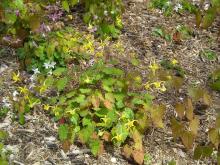
Seedlings, seedlings, seedlings, that will be the challenge this year. Four flats of Epimedium on the left and center, 2 flats of Jeffersonia on the right. I'm going to ask my wife to row-out some of the seedlings in a new bed.
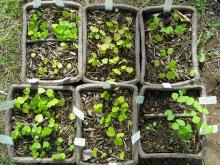
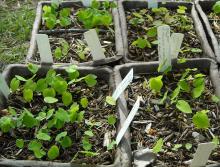
Left: two views of a hybrid between E. x youngianum 'Freckles' x grandiflorum 'Princess Susan'; in one view the speckling can be seen better. Has the clearer pink and white flowers of 'Princess Susan'. Right: two views of E. gr. 'Princess Susan'.
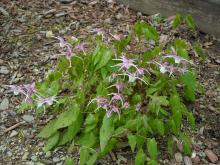
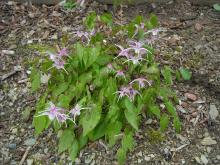
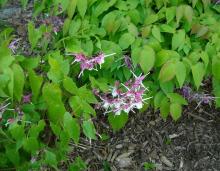
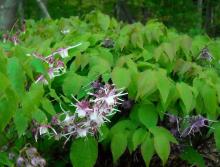
Epimedium hybrid "Mark's Star" ;D (on the left) has a companion on the right, a hybrid of similar form and narrow pointy stars, in softest pale lilac.
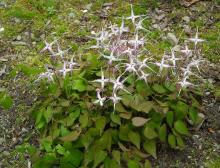
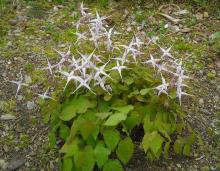
WimB (not verified)
Re: Epimedium 2011
Mon, 05/09/2011 - 10:33pmNo gnats over here, from what you guys have told, I'm very glad we don't have them over here!
WimB (not verified)
Re: Epimedium 2011
Mon, 05/09/2011 - 10:34pmVery nice Mark, I'd buy a 'Mark's Star' ;D if it were for sale, it's one of the best hybrids you have shown here. Although the cross between 'Princess Susan' and 'Freckles' is very nice too.
gerrit (not verified)
Re: Epimedium 2011
Fri, 05/13/2011 - 10:45amMark, a nursery here in Holland have listed a number of epimediums in their catalogue and I wonder if they exist or well-labelled.
Please help me to find out and give your opinion.
Epimedium warleyense 'Koper" and Epimedium lilacinum. Are they fairytale epimediums?
Epimedium "Creeping Yellow" This is interesting. It's listed by a nursery in Lilliesleaf, Scotland. I tried to visit this nursery last year, when I was on a vacation in Scotland, but the nursery didn't exist anymore. What happened with this epimedium. Could it appear now in Holland? I saw it also somewhere in the US.
Epimedium "Violet Queen". Maybe there is an Epimedium sempervirens "Violet Queen" PDN perhaps?
And for fun, 2 pictures of my young plant Epimedium wushanense "Caramel", blooming for the first time
Richard T. Rodich
Re: Epimedium 2011
Fri, 05/13/2011 - 6:58pmGerrit, that foliage is way cool! ;D
I would grow it just for that!
Mark McDonough
Re: Epimedium 2011
Fri, 05/13/2011 - 8:16pmGerrit, will reply as soon as I can, hopefully this weekend. Next week I'm off-site traveling to various sites for work, and this weekend is 200% booked, must prepare for a conference where I'm presenting (also for work). I think I liked being unemployed much better. Please bear with me.
Mark McDonough
Re: Epimedium 2011
Sat, 05/14/2011 - 9:32pmI believe E. warleyense 'Koper' is a language-translation issue, and not a valid cultivar. The only links to the name source as Romanian, and google comes up with such terms as "koper-oranje" describing the flowers... I have to believe this is just language semantics and not an actual cultivar name.
The name E. "lilacinum" seems to be applied to either E. glandiflorum 'Lilacinum' or E. x youngianum 'Lilacinum'. Prossibly inconsequential and not worth troubling over.
E. 'Creeping Yellow' represents dubious marketing... the plant a rather mundane white-flowered plant, but "gets its name from foliage that is pale yellowish-green". It is reported to have "emerging leaves rimmed with copper and bronze and mottled with red speckles." The name "creeping yellow" seems misleading or a poor choice. :(
http://www.stonyfordcottagenursery.co.uk/epimedium-creeping-yellow-bare-...
http://www.munchkinnursery.com/shopping/shopexd.asp?id=57
Your Epimedium wushanense 'Caramel' is awesome, I want to obtain this one badly!
Mark McDonough
Re: Epimedium 2011
Mon, 05/16/2011 - 9:24pmA hurried post, last year I selected a very small Epimedium hybrid seedling with tiny light pink flowers, but it's the neat clump of speckled foliage that is an interest... I like it:
So many Epimedium have flowered, are in flower, and ready to flower; I hope to catch up. Here's one that I don't think I've shown before, E. grandiflorum 'Circe' (left); really nice bright flowers above the foliage. Also, a first glimpse at the late-to-emerge high alpine selection of E. grandiflorum named 'Cranberry Sparkle' (right); both are Garden Vision Epimedium introductions. Cranberry Sparkle has flower buds are dark-red-purple from above, an awesome cultivar.
The next two views show another 3-year hybrid that I like, with light white-pink sepals from above, but purplish-plum petals and center, catching my eye. Will wait to see how it clumps up in years 4-5 to make a determination.
Lori S. (not verified)
Re: Epimedium 2011
Mon, 05/16/2011 - 9:35pmWhat an amazing sight your garden must be!! :o From these little snippets of photos, it looks simply fantastic!
Mark McDonough
Re: Epimedium 2011
Mon, 05/16/2011 - 9:49pmThanks Lori, I'll be posting some general garden views this weekend... the Epimediums make it easy for the garden to look nice ;)
Trond Hoy
Re: Epimedium 2011
Mon, 05/16/2011 - 11:49pmMark, I agree with Lori!
You can't sleep much or watch the telly - both attending to your work and to your beautiful garden!
gerrit (not verified)
Re: Epimedium 2011
Tue, 05/17/2011 - 4:07amEpimedium gr. 'Circe' is a lovely one. It catched my eye already before. A very good performance with her flowers elegant above the leaves. A very vivid attractive colour because of the long white spur tips. One of the many species, we'll never see here.
Finally the rain has arrived after 2 months with no single drop. We've had a bad epimedium-year, the flowers didn't develop well, with temperatures above 20 degrees C. And sunshine almost every day. The flowers left only a few days. Maybe we'll see a second flush.
Mark McDonough
Re: Epimedium 2011
Wed, 05/18/2011 - 7:44pmToo bad about the drought you've had; reminds me of last summer's terrible record-breaking drought and heat waves. In fact, for the first time ever with Epimedium, I had a number of losses this spring, I'm sure due to the record drought in summer 2010 (and a large part of Autumn 2010) and with a 100% watering ban in town. About 10 species/cultivars here were total "no-shows" this spring, and maybe 12-14 others are barely alive with a few late-emerging leaf sprouts and most parts of the rhizomes dead, all weakened from the drought and collapse of all foliage the previous summer.
Mark McDonough
Re: Epimedium 2011
Wed, 05/18/2011 - 8:22pmA miscellany of Epimedium tonight. We've been pummeled by rain for the last several days, so, some "eppies" are looking a bit down-trodden, but I snapped a few recent pics to share here, even though they may look a bit dark.
E. pubescens "Shaanxi Forms", the hardy version of E. pubescens. I like this one because it is very low growing, with colorful foliage, reliably evergreen foliage, and late display of starry white flowers (just starting now) and a rebloomer.
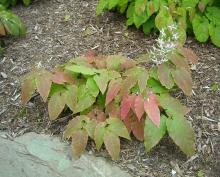
E. x cantabrigiensis "Red Form" - a cute plant with tiny red and yellow flowers.
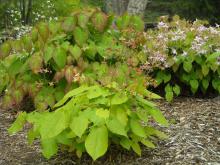
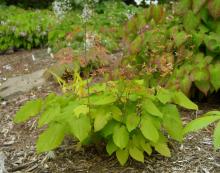
E. x youngianum hybrid seedlings, the foreground plant shows small thimbles of white with light pink sepals.
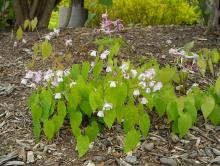
Some yellows:
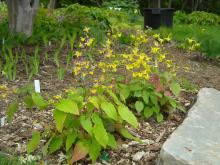
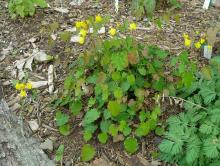
left: E. davidii EMR x ?brevicornu hybrid (small flowers) and E. davidii EMR open-pollinated seedling plant; much more prolific flowering.
right: E. x 'Lemon Zest' - a cute one with small spur-challenged yellow thimbles.
Left: E. grandiflorum 'Cranberry Sparkle' - the darkest cranberry red flowers of any "eppie", this high-alpine selection is outstanding. So far, I haven't gotten a good photo, so what I show will have to do.
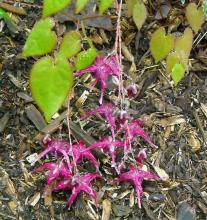
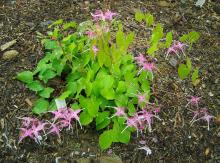
Right: Epimedium hybrid with rich pink sepals and wide-spreading white spurs.
E. x 'Domino' garden scene:
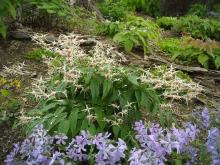
gerrit (not verified)
Re: Epimedium 2011
Thu, 05/19/2011 - 2:12amWhat a breathtaking view of your woodlandgarden with the majestic E.x domino. I'm so happy, I purchased this one a few weeks ago.
Mark, I enjoyed looking and studying your pictures. Thanks a lot for doing it.
The possible hybrid between E.davidii EMR and E. brevicornu took my special interest. I wonder, how the spurs can be pink, as the parent has white flowers. I was thinking of E. brachyrrhizum perhaps.
The E.gr.'Cranberry Sparkle' is a stunner indeed. A better photo you showed already in reply 87. Is this the most red form of all? I'm thinking of E.gr.'Yubae' and maybe E.gr.'Red Queen'.
Gerrit
gerrit (not verified)
Re: Epimedium 2011
Thu, 05/19/2011 - 2:22amSorry to hear about this terrible summer last year. I won't complain any more. I watered my plants every day, especially my rock garden with limestones (tufa). They even didn't talk about a watering ban. So actually no problems over here. But to loose so many Epimediums, that's something. When it's such a bad weather, the plants suffer, the gardener suffers too.
Mark McDonough
Re: Epimedium 2011
Thu, 05/19/2011 - 5:27amCongratulations on getting 'Domino', one of the very best cultivars out there.
With the possible davidii hybrid with brevicornu, this is a best guess... the seedling appeared under E. davidii EMR (so I label it accordingly) and close by is E. brevicornu (a very willing parent) and E. stellulatum and E. pubescens "Shaanxi Form", each of those three has tiny white starry blooms. I have about 1-1/2 dozen E. brevicornu hybrids (many with E. membranaceum), and they all follow a similar theme... small flowers with white sepals (often spotted red or pink, making them look pinkish), and amplified yellow petal cups... cute little things. The hybrids where I'm quite convinced they involve E. brevicornu x membranaceum pick up the white pink-spotted sepals of membranaceum, showing up a bit more pink in the hybrid. But, it's just a guess :)
A few more garden views... all taken on dreary cool and rainy days... lots of Epimedium, but other plants like Pulmonaria, Ariseama, Cypripedium, Phlox, etc.
gerrit (not verified)
Re: Epimedium 2011
Thu, 05/19/2011 - 12:38pmWow, what a fantastic group of Cypripedium. C.parviflorum pubescens, I guess? If it is so, it's native in your region. Do they still grow a lot in the woods of N.America?
Trond Hoy
Re: Epimedium 2011
Thu, 05/19/2011 - 1:03pmMark, your garden is marvellous :o :D
WimB (not verified)
Re: Epimedium 2011
Thu, 05/19/2011 - 1:04pmMark, I can only agree with Gerrit, that is one impressive clump of C. parviflorum var. pubescens.
What's the plant growing underneath the two Arisaema sikokianums?
In total it's a very nice woodland corner....I find the best pictures of woodland plants are often taken during these dreary days....wish we had some rainy days (unlike our northern neighbours in the Netherlands we still haven't seen any rain)
Richard T. Rodich
Re: Epimedium 2011
Thu, 05/19/2011 - 7:02pmI especially liked the E. davidii hybrid, too. And besides all your wonderful pics of your wonderful garden, Mark, I always appreciate your insightful remarks that accompany. They are certainly not just pretty pictures!
Pages